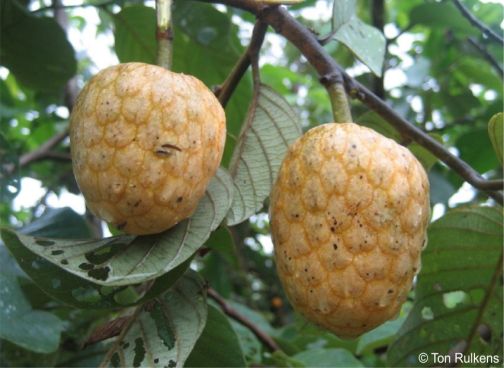Annona senegalensis

|
|
Annona senegalensis Common
Names: African
Custard Apple, Wild Custard Apple, Wild Soursop, Desert Custard Apple Scientific Classification Kingdom: Plantae Phylum: Tracheophyta Class: Magnoliopsida Order: Magnoliales Family: Annonaceae Genus: Annona Species: A. senegalensis Synonyms: Annona
arenaria Thonn., Annona chrysophylla Bojer, Annona porpetac Baill., Annona senegalensis subsp. oleracea R.E.Fr. Morphological Description Annona
senegalensis, commonly known as African Custard
Apple, is a deciduous shrub or small tree, typically growing 2–7 m tall,
occasionally reaching 11–15 m under optimal conditions. Its key features
include: · Stem: Bark
grey-brown, rough, often fissured; young branches pubescent, becoming glabrous · Leaves: Alternate,
oblong to elliptic, 6–18 cm long, 4–11 cm wide, leathery, green to
bluish-green, with brownish hairs on the underside · Flowers: Solitary
or in small clusters, greenish-yellow to pale yellow, 2–3 cm in diameter, with
waxy, fragrant petals · Fruit: Round
to ovoid, 5–10 cm in diameter, green ripening to yellow-orange, with creamy,
sweet, pineapple-like pulp containing numerous black seeds Distribution and Habitat Annona
senegalensis is native to sub-Saharan
Africa, from Senegal and Gambia in West Africa to Sudan and Ethiopia in the
east, and south to Namibia, Botswana, and South Africa. It thrives in: · Ecosystems: Savannas,
woodlands, forest margins, grasslands, and riverine thickets · Climate: Tropical
to subtropical, with rainfall of 500–1,500 mm annually and temperatures of
20–35°C · Soils: Well-drained,
sandy to loamy, tolerating nutrient-poor conditions · Altitude: Sea
level to 2,400 m In Nigeria, it is widespread in
northern states like Kaduna and Kano, and southern regions, often found in open
savannas and near watercourses Ethnopharmacology Annona
senegalensis, commonly known as wild custard
apple or African custard apple, is an important medicinal plant traditionally
used across many African countries. Various parts of the plant including the
leaves, bark, roots, and fruits are valued for their antimicrobial,
antidiabetic, antimalarial, anti-inflammatory, antioxidant, and analgesic
properties. In traditional medicine, it is used to treat fevers, malaria,
diarrhea, dysentery, respiratory infections, wound infections, toothaches, and
snakebites. The bark and leaves are often prepared as decoctions to manage
gastrointestinal disorders and skin conditions, while the fruits are consumed
for their nutritional and digestive benefits. Phytochemical analyses have
identified bioactive compounds such as alkaloids, flavonoids, acetogenins,
saponins, and tannins, which contribute to its medicinal effects. While widely
appreciated in traditional practices, further pharmacological and clinical
studies are necessary to validate its therapeutic potentials and ensure its
safe use. · Antimalarial Activity: Methanol
leaf extracts inhibited Plasmodium berghei by
96.2% at 800 mg/kg in mice, surpassing chloroquine, validating their use for
malaria in Nigeria and Benin. In Cameroon, leaf extracts were toxic to Anopheles gambiae larvae, supporting vector control (Ajaiyeoba et al.,
2006; Donhouedé et al., 2022;). · Antimicrobial Activity: Aerial
part extracts containing (-)-anonaine and (+)-nornantenine inhibited Streptococcus mutans (MIC 0.12–0.25 mg/mL), validating their use for oral
infections in Nigeria. Root bark extracts were active against Staphylococcus aureus (MIC 62.5 mg/mL), supporting wound and skin infection
treatments in Uganda (Lall et al., 2017; Okunade et al., 2004;). · Anti-inflammatory
and Antiulcer Activities: The ethyl
acetate fraction of Annona senegalensis root bark extracts exhibited
significant anti-inflammatory and antiulcerogenic activities in vitro and in
vivo. At a dose of 200 mg/kg, it showed notable cytoprotection (Konaté et al.,
2021). · Analgesic
and Anti-inflammatory Properties:
Aqueous leaf extracts produced significant, dose-dependent reductions in edema
induced by carrageenan and dextran in rats. Maximum inhibition was 57.14% at
200 mg/kg (Koussoubé et al., 2024). · Antimalarial
Activity: Methanol extracts of leaves
demonstrated better antimalarial activity against Plasmodium berghei than
chloroquine diphosphate, with 96.2% chemosuppression (Donhouedé et al., 2022). · Antivenom
Activity: Methanol extracts of root bark
significantly reduced hyperthermia and detoxified cobra (Naja nigricollis)
venom in rats (Donhouedé et al., 2022). · Antidiarrheal
Activity: Methanol stem-bark extracts
exhibited antidiarrheal effects in rats, reducing gastrointestinal motility and
frequency of defecation (Wikipedia, n.d.). ⚠ Toxicity Profile: Annona senegalensis contains acetogenins (e.g., annogalene) and alkaloids,
which may be neurotoxic at high doses, potentially causing neurological
symptoms similar to atypical Parkinsonism. Toxicological studies indicate that
A. senegalensis has a low acute toxicity, with an LD₅₀ greater than 5,000 mg/kg
body weight in mice. However, high doses may lead to adverse effects (Ilboudo
et al., 2019). Additional Uses · Culinary: The
fruit’s sweet, pineapple-like pulp is eaten fresh, used in sherbets, or made
into drinks in Nigeria and Benin. Leaves are occasionally used as a vegetable
in soups. · Industrial: Bark
tannins are used for leather tanning in Ghana; the wood, lightweight and
durable, is used for tool handles and construction. · Insecticidal: Leaf
extracts are used as insecticides against pests like Aedes aegypti in Cameroon, leveraging acetogenins · Agroforestry: The
tree’s nitrogen-fixing roots improve soil fertility, making it valuable in
savanna agroforestry systems in Burkina Faso · Cultural: In
Hausa traditions, leaf infusions are used for spiritual cleansing; fruits are
used in fertility rituals in Nigeria References
External Links More Pictures |
|
| Compounds of Annona senegalensis |
|
| References |